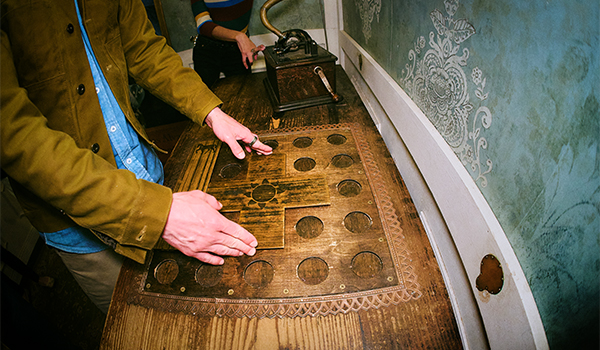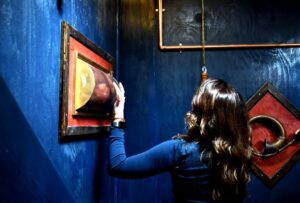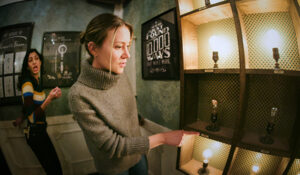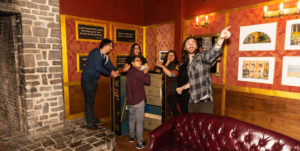A Connoisseur’s Checklist: 7 Signs of a Premium Escape Room
Beyond Locks and Keys
The escape room industry has evolved far beyond its humble origins of simple locks and hidden keys in a single room. A new tier of connoisseur-level experiences has emerged, offering cinematic adventures that rival live theater and immersive gaming. For players seeking more than just a puzzle, but a true adventure, knowing how to spot these high-production-value games is essential.
As the creators of award-winning adventures, we’ve developed an insider’s checklist to help you distinguish a truly premium escape room from a basic one. Before you book your next outing, use these seven indicators to identify an experience that is worth your time and investment.
1. Deep Narrative Integration
A hallmark of a premium room is a story that serves as the foundation for the entire experience, not just a decorative theme. In these games, the narrative and the puzzles are deeply intertwined. Experts in interactive design call these ‘diegetic’ puzzles, meaning the challenges make logical sense within the world of the story and actively advance the plot [1]. This approach transforms players from passive observers into active participants whose choices shape the story.
- Green Flag: The story provides a compelling objective with high stakes, such as saving the nation from a looming threat or uncovering a historical conspiracy. The puzzles you solve are the direct actions needed to achieve that goal.
- Green Flag: The narrative is rich and consistent, with every element in the room serving the story. The best experiences even build a larger universe by connecting narratives between different games, creating a cohesive world for players to explore over multiple visits.
- Red Flag: The room is a random collection of disconnected puzzles. Be wary of an experience advertised as a ‘pirate ship’ that is filled with generic brain teasers like Sudoku or riddles that have no connection to being a pirate.
2. Immersive Set and Environmental Design
In a world-class escape room, the environment is a character in itself. The experience should feel like stepping onto a movie set, not into a decorated office. This concept, known as environmental storytelling, is a technique borrowed from the masters of themed entertainment, like Disney Imagineering, to build immersive worlds. The environment should tell a story on its own, even without words [2].
- Green Flag: The set design is detailed, historically accurate, and completely absorbing. The illusion begins the moment you arrive, not just when the timer starts. The materials feel authentic, from the weight of a prop to the texture of the walls.
- Green Flag: The experience is housed in a unique and significant venue. An adventure set within a historic landmark, for example, offers a level of authenticity and grandeur that a typical commercial space cannot replicate. The history of a location like San Francisco’s Palace of Fine Arts can transport players to another era before the first clue is even found.
- Red Flag: The immersion is frequently broken by reminders of the outside world. Visible ceiling tiles, modern light switches, exposed wiring, or props that are clearly cheap party store decorations detract from the authenticity of the world.
3. Advanced and Seamless Technology
Premium experiences use technology to create moments of pure magic, not to present frustrating obstacles. The best tech is invisible; it is integrated so seamlessly into the environment that it feels like a natural part of the story’s world. This could manifest as a hidden door revealing itself, a painting that speaks, or a soundscape that reacts to the players’ actions.
- Green Flag: Technology is used to create unique and tactile puzzles that go far beyond combination locks. These interactions should feel innovative, surprising, and satisfying, making players feel like they are truly interacting with a dynamic world.
- Green Flag: The technology feels appropriate to the time and place of the story. For instance, in a game set in a historical inventor’s workshop, the technology should feel like his own secret creations, blending mechanics and electronics in a way that is both clever and period-appropriate, as one might find in an adventure like The Edison Escape Room.
- Red Flag: The technology is clunky, unreliable, or obvious. Exposed wires, visible computer monitors displaying a desktop, or puzzles that require you to wiggle a sensor just right are all signs of a less polished experience.
4. Thoughtful Puzzle Design and Flow
The puzzle structure of a premium game is engineered to maximize engagement and teamwork. This relates to the psychological concept of a ‘flow state,’ where challenges are perfectly balanced with a player’s skills to create deep immersion [3]. Achieving this state requires clear goals and a sense of progress, which great escape rooms provide.
- Green Flag: The game features a wide variety of puzzles that require different skills, including logic, observation, communication, and physical interaction. This ensures that every member of the team has an opportunity to shine.
- Green Flag: The puzzle structure is non-linear, allowing smaller groups to split off and work on different challenges simultaneously. This keeps the entire team engaged and is a hallmark of games designed for true collaboration.
- Red Flag: The game is entirely linear, forcing a large group to stand around and watch one person solve a single puzzle. Another red flag is puzzles that are obtuse or rely on frustrating leaps of logic, pulling players out of the experience.
5. Generous Time and a Private Experience
A premium adventure cannot be rushed. The standard 60-minute escape room is often a holdover from the industry’s early days and is typically insufficient for a deep, story-rich experience. Furthermore, the immersion of a carefully crafted world can be instantly shattered by the presence of strangers.
- Green Flag: The experience is guaranteed to be private for your group. This allows your team to communicate freely and become fully absorbed in the story without the distraction of navigating social dynamics with strangers. All Palace Games experiences are private.
- Green Flag: The game duration is 90 minutes or longer. Experiences like The Roosevelt Escape Room, which run for 100 minutes, provide the necessary time for complex narratives to unfold and for teams to tackle more substantial, multi-layered challenges.
- Red Flag: You are required to book individual tickets and may be paired with other players. While this can lower the per-person cost, it fundamentally changes the dynamic and compromises the immersive quality of the adventure.
- Red Flag: A 60-minute time limit often signals a simpler game with fewer puzzles and a less developed story.
6. High-Touch Customer Service
In a premium escape room, the service is part of the show. The Game Guide (or Game Master) is more than an employee watching a monitor; they are a facilitator of the adventure. Drawing parallels from immersive theater, where hosts are crucial for guiding the audience, a great Game Guide enhances the narrative. As research on immersive performance shows, the guide’s role is to shape the experience and direct engagement [4].
- Green Flag: Your dedicated Game Guide is in-character, delivering hints that feel like a natural part of the story. They are attentive, personalizing the experience to your group’s progress and energy.
- Green Flag: The entire customer journey is seamless, from clear pre-arrival instructions to a dedicated space to celebrate and debrief afterward. The availability of a private post-game area shows a company cares about the complete event, not just the time spent in the room.
- Red Flag: The Game Master is disengaged, providing generic, uninspired hints via a text screen, such as, ‘Have you looked at the bookshelf again?’ This transactional approach shows a lack of investment in the player experience.
7. A Reputation for Excellence
Finally, a truly premium escape room will have a reputation to match. While any room can accumulate positive reviews from first-time players, the most telling endorsements come from seasoned enthusiasts and official industry awards. These are the most reliable external validators of quality.
- Green Flag: The company is consistently recognized by international awards. The most prestigious of these is the Top Escape Rooms Project (TERPECA), which uses votes from hundreds of expert players worldwide to identify the best of the best.
- Green Flag: The price reflects the quality. A higher, flat-rate booking fee, such as a set price for a private group as detailed in our booking policies, is a sign of a company that has invested heavily in custom design, advanced technology, and a prime location. It is a commitment to a private, complete experience.
- Red Flag: A very low price point can be a warning sign. While not always the case, it may indicate a reliance on off-the-shelf puzzles, minimal set dressing, and a less polished overall product.
By keeping these seven signs in mind, you can move beyond generic puzzle rooms and discover the incredible, story-driven adventures that represent the pinnacle of the escape room industry. Look for the creators who obsess over the details, because that is where the magic lies. lies.



